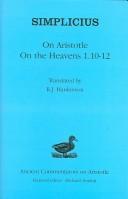| Listing 1 - 1 of 1 |
Sort by
|

ISBN: 9781472557438 1472557433 9780725632321 9781472501370 0715632329 9780715632321 9781472557841 1472557859 9781472557414 9781472557377 1472557417 1472557379 9781472557957 9781472558121 9781472557858 1472557913 147255812X 1472557840 9781472557919 1472557956 9780715630709 9780715638446 9780715633427 9780715638439 0715638432 Year: 2006 Publisher: London Duckworth
Abstract | Keywords | Export | Availability | Bookmark
 Loading...
Loading...Choose an application
- Reference Manager
- EndNote
- RefWorks (Direct export to RefWorks)
"Aristotle believed that the outermost stars are carried round us on a transparent sphere. There are directions in the universe and a preferred direction of rotation. The sun moon and planets are carried on different revolving spheres. The spheres and celestial bodies are composed of an everlasting fifth element, which has none of the ordinary contrary properties like heat and cold which could destroy it, but only the facility for uniform rotation. But this creates problems as to how the heavenly bodies create light, and, in the case of the sun, heat. The topics covered in this part of Simplicius' commentary are the speeds and distances of the stars; that the stars are spherical; why the sun and moon have fewer motions than the other five planets; why the sphere of the fixed stars contains so many stars whereas the other heavenly spheres contain no more than one (Simplicius has a long excursus on planetary theory in his commentary on this chapter); discussion of people's views on the position, motion or rest, shape, and size of the earth; that the earth is a relatively small sphere at rest in the centre of the cosmos."--Bloomsbury Publishing.
Cosmologie antique --- Astronomie antique --- Mécanique céleste --- Aristote, --- Cosmology, Ancient. --- Physics --- Aristotle. --- Aristotle. De caelo. 1.10-12. --- Cosmology -- Early works to 1800. --- Aristotle --- Cosmologie antique. --- Astronomie antique. --- Mécanique céleste. --- Aristote --- Cosmology, Ancient --- Celestial mechanics --- Astronomy, Greek --- Astronomy, Ancient --- Cosmology - Early works to 1800 --- Motion --- Science, Ancient --- Four elements (Philosophy) --- Logic --- Cosmology --- Astronomy --- Astronomy, Ancient. --- Astronomy. --- Cosmology. --- Aristoteles, --- Aristoteles. --- De caelo (Aristotle). --- Geschichte 550. --- Philosophy of nature
| Listing 1 - 1 of 1 |
Sort by
|

 Search
Search Feedback
Feedback About UniCat
About UniCat  Help
Help News
News